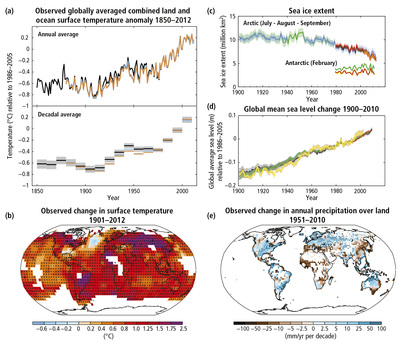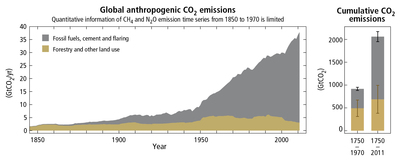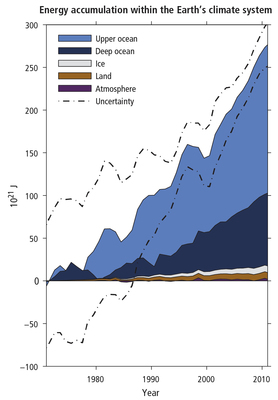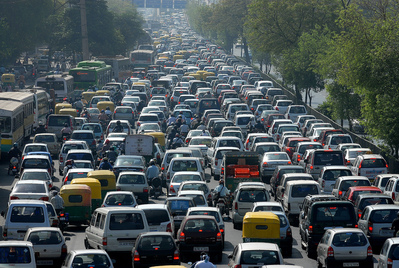Climate Change
IPCC 5 Climate Change
Indicators of Changing Climate

(click image to enlarge)
Multiple observed indicators of a changing global climate system.
Source: IPCC AR5 Synthesis Report, Topic 1, Observed Changes and their Causes
The above figure is from the IPCC (Intergovernmental Panel on Climate Change) AR5 report, issued in 2013-2014. It presents the following global changes:
- variation in surface temperatures for both land and oceans
- changes in sea ice extent
- changes in mean sea level
- changes in annual precipitation
Image (a) shows changes in temperature since 1850. Image (b) shows in color the extent of change at various points on the globe from 1901 to 2012. As one can see from (a), the earth's land and sea surface temperatures stayed fairly steady from 1850 to approximately 1900, but have been increasing since the beginning of the 20th century.
Anthropogenic CO2 Emissions

(Click image to enlarge)
IPCC AR5 Synthesis Report Figure 1.5
Annual global anthropogenic carbon dioxide (CO2) emissions
(gigatonne of CO2-equivalent per year, GtCO2/yr)
from fossil fuel combustion, cement production and flaring, and forestry and other land use.
As is clear in the above figure, since the beginning of the 20th century, the rate of emission of CO2 from fossil fuels and, to a lesser extent, from forest clearing has been steadily increasing. Comparing this figure to the change in land/sea surface temperatures, there is a strong correlation between rising temperature and increasing CO2 emissions.
Global Energy Accumulation

(click image to enlarge)
Energy Accumulation Within the Earth's Climate System
IPCC AR5 Synthesis Report, Topic 1, page 42, Figure 1.2
Since the middle of the 20th century, the earth has been accumulating energy in all its earth systems at an accelerating rate. The above figure provides information on how that energy has been distributed among the atmosphere, the land, ocean and ice. The most striking aspect of that distribution is that the bulk of accumulated energy has wound up in the oceans. Water has a very strong heat capacity, and it covers expansive areas of the globe.
Were it not for the capacity of earth's oceans to hold vast amounts of human-generated heat and a sizable amount of greenhouse gases, the earth would be considerably warmer that it is today.
Disruption of Ecosystems
The environmental disruptions that are the result of climate change from excessive use of fossil fuels are both rapid and extensive. Many of the millions of species of animals and plants on earth are incapable of adjusting to those disruptions quickly enough to survive as a species. The threat to ecosystems is particularly acute in the tropical and polar latitudes, but even in more temperate regions of the planet, species survival is often imperiled. This danger to the inhabitants of each ecological environment will only increase, as the extent of greenhouse gas emissions grows.
The Human Difference

(click image to enlarge)
The rise in the Earth's temperature is mostly attributable to one primary cause, human use of fossil fuels - coal, oil and natural gas. Although humans have used fossil fuels in one form or another for various purposes for many thousands of years, it has only been since the beginning of the industrial age, which started around 1750, that the use of these fuels has been sufficiently massive to cause substantial climate and environmental problems.
When fossil fuels burn, they produce carbon dioxide, among other products. Once carbon dioxide is released into the atmosphere, it tends to stay around for a long time (hundreds of years). One of its properties is that it acts as an insulating blanket, reflecting some heat from the earth back toward the earth, rather than letting all of that heat freely escape into space. This is called the "greenhouse effect".
The greenhouse effect is a good thing when the amount of carbon dioxide in the air is sufficient for maintaining an average temperature favorable for life on Earth. Indeed, Earth's climate has been stabilized for hundreds of millions of years by just the right amount of carbon dioxide in the air. However, when large amounts of excess carbon dioxide are present, the Earth's average temperature rises. That phenomenon produces unfavorable climate warming results that we are starting to see more and more in the Earth's climate patterns today.
There are other gases that contribute to the greenhouse effect, in addition to carbon dioxide. These include methane (natural gas), ozone, and nitrous oxide. Many of these compounds are even stronger than carbon dioxide in their power to trap heat and keep it from escaping from the earth.
What is Happening Now?
Current and historical measurements provide evidence of global warming of the Earth's climate:
- global atmospheric temperature increase of 1.8°F (1°C) between the years 1900 and 2017
- rise in oceanic temperature
- increases in the frequency of intense rainfall
- decreases in snow cover and sea ice
- receding of glaciers
- more frequent and intense heat waves
- rising sea levels
- widespread ocean acidification
- decrease in ocean oxygen
What Will Happen Next?
It is safe to say that the Earth's temperature is going to continue rising toward some maximum peak over the next several decades. This assertion is possible because the carbon dioxide already released into the atmosphere has not yet reached its full warming potential. It is also safe to predict that as more carbon dioxide and other greenhouse gases (GHG) are released by the continuing use of fossil fuels, the ultimate temperature peak will become greater and greater.
However, it is not possible to be exact in any prediction of future temperatures. The best we can do is use computer models of the Earth's natural climate patterns to predict what will happen under various "forcings", long-term influences on climate conditions from both natural and manmade causes. Examples of forcings are variations in light radiation from the sun, volcanoes, and human-produced greenhouse gases.
However, even though we cannot be 100% certain in any prediction of climate change or its effects, it is still possible to generate a scenario of outcomes that have a high degree of probability of occurring. Those include the following.
- Higher average temperatures worldwide, with the greatest temperature increases occurring at greater latitudes (nearer the poles),
- Warming of the oceans, with a subsequent rise in sea level, due to expansion of ocean water as it heats up. This warming will also cause a considerable increase in the melting of the Arctic polar ice cap. All these phenomena have been measured and are presently occurring,
- Increased acidity of the oceans, the result of a greater concentration of dissolved CO2, an acidifying agent,
- Disruption of ocean ecosystems as acidity and temperature levels increase, an effect which can be detected today in observable damage to shell-producing animals (e.g. various coral species),
- Increased frequency of droughts and their severity,
- Greater hurricane severity,
- Disruption of ecosystems, with subsequent extinctions of plant and animal life,
- Depletion of fresh water resources, with detrimental effects on agriculture and human health,
- Migration of mosquitoes and other carriers of infectious diseases into latitudes higher than their current, more tropical habitats.
What Can We Do?
Action to cope with global warming falls into three general categories:
1. Mitigation involves reducing our use of fossil fuels (coal, oil, natural gas) or eliminating their use altogether by changing our energy sources to renewable, sustainable fuels (e.g. solar, wind, geothermal, biomass, hydropower) and, through conservation and improved technologies, making our current use of fuels more efficient.
2. Adaptation to the changes brought on by global warming will be necessary to varying degrees around the globe. Even current levels of greenhouse gases are sufficient to produce disturbances in climate that will require us to change our ways of life. Thus, mitigation and adaptation go hand-in-hand, as we make the adjustments necessary to survive in a new, more challenging world.
3. Geoengineering is the use of technology to purposely alter the climate to effect changes that reverse or compensate for the emerging effects of global warming. These techniques are controversial and, for the most part, are untried. However, increasing attention is being paid to the geoengineering option, as the difficulties of implementing effective mitigation and adaptation policies become evident.
We will discuss these three possibilities in greater detail in other sections of this site.
How Much Time Do We Have?
This is a difficult question to answer, because climate and the extra burden and changes that are being imposed upon it by human-generated greenhouse gases (GHG) are very complex. Scientists know a lot about climate and how GHG's are affecting it, and predictions of temperature and other aspects of climate can be generated using computer models of the Earth system. However, even the best models involve some guesswork and a variety of simplifying assumptions about the Earth's climate systems. The future course of climate development will be the result of a wide variety of powerful and interacting forces.
Nonetheless, some general idea of how various environmental conditions (e.g. temperature, humidity, ocean levels and acidity, and melting of polar ice caps) will proceed in the future can be obtained from climate models. Some time frames for how those conditions develop can also be derived. The best models for predicting these time frames consistently predict a range of effects that started with the beginning of the Industrial Revolution and are now becoming more and more obvious with increasingly frequent and severe storm, drought and flooding conditions worldwide.
The predictions that arise from these models consistently indicate an enduring warming of the earth's climate over hundreds and possibly thousands of years. Any natural lessening of these effects will be very slow, because GHG's are only very gradually absorbed by natural, chemical phenomena in the terrestrial and oceanic systems. That means that we humans must immediately and radically limit our use of fossil fuels and switch to other, cleaner sources of energy. We will discuss these options in other portions of this site.
Who Will Be Most Affected?
Although the effects of global warming will be felt to some extent by everyone, the populations most immediately affected will be those living in areas vulnerable to increased severity of already existing, destructive weather phenomena, such as severe tornadoes and hurricanes, drought and flooding. These will be the disturbances most readily observed and the soonest to manifest, as the increasing levels of greenhouse gases (GHG) work their immediate effects on the global climate.
However, the effects of GHG's develop over extended periods of time, long after the initial releases of GHG's are over. These extended periods range from centuries to tens of thousands of years. During that time, as the systems comprising the Earth's climate stabilize in a new state of equilibrium, the full range of disruptive climate possibilities can be expected.
For example, if global warming ever reaches the point where the Greenland and West Antarctic ice shelves start to melt, the result would certainly be a rising of sea levels worldwide. There is no certain prediction that such an event will happen within this century, but if such an event did eventually occur, it would submerge low-lying population areas, particularly those situated in river delta environments. The heavily populated and impoverished nation of Bangladesh is an example of the horrific effects of such a catastrophic climate change.
In any event, we can expect that the people most hard-hit by global warming will be those in the most heavily populated and impoverished areas, which are, of course, those least able to take adaptive measures to cope with the drastic changes necessary for survival.
What About the Skeptics?
The physical causes, effects, mediation and possible correction of climate change are basically scientific and engineering issues. The relevant data are measurable, albeit incomplete in many instances, and their analysis is conducted using critical, scientific examination and debate. In this light, science and the study of climate change flourish on skepticism and the careful review of all data. Such review must be conducted by informed critics who are trained in the scientific and engineering concepts involved. Creative experimentation and doubtful skepticism work hand in hand to make good science.
However, things are not always quite that simple. The issue of climate change reverberates throughout the global economy and all of the world's political institutions, because the energy used to drive modern economies is inextricably linked to the GHG's responsible for global warming. Any decision to curtail GHG emissions necessarily has wide-ranging economic and, therefore, political repercussions.
In many ways, the healthy skepticism that is intrinsic to the scientific method can be complicated and difficult to understand. Furthermore, progress can be constrained by the natural human tendency to navigate difficult social and cultural disturbances, such as global warming, using criteria that reflect the interests and visions of competing sectors of society. We, as a global society, have to make difficult decisions on this very important matter, and everyone wants to come out of the process with as little pain as possible for themselves, their families and their societies. We often differ on how to do that collectively and democratically.
It is clear that the bases for scientific and political skepticism need to be carefully examined, in order to understand the technical and political aspects of the situation. Accordingly, it is necessary to draw on and to trust the wisdom of experts in science, particularly climatologists, to clarify and inform our understanding of climate change and the measures we must implement to limit its negative impacts.